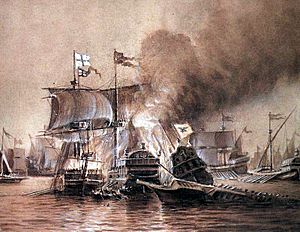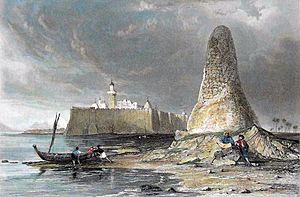Battle of Djerba facts for kids
Quick facts for kids Battle of Djerba |
|||||||
|---|---|---|---|---|---|---|---|
 Contemporaneous illustration of the naval battle off Djerba. |
|||||||
|
|||||||
| Belligerents | |||||||
|
|
|||||||
| Commanders and leaders | |||||||
| Strength | |||||||
| 54 galleys, 66 other vessels Other sources: 100 ships total |
86 galleys and galliots | ||||||
| Casualties and losses | |||||||
| 60 ships sunk or captured, 9,000 ~ 18,000 men killed, 5,000 prisoners (during siege) |
Few galliots lost, About 1,000 men |
||||||
The Battle of Djerba (called Cerbe by the Ottomans) was a big naval battle. It happened in May 1560 near the island of Djerba, which is off the coast of Tunisia. In this battle, the Ottomans, led by Piyale Pasha, defeated a large fleet of Christian ships.
This Christian fleet was made up of ships from several European powers. These included Spain, the Papal States (lands ruled by the Pope), the Republic of Genoa, and the Knights of Saint John from Malta. The Christian forces lost many ships and the island of Djerba. This victory showed how powerful the Ottoman Empire was in the Mediterranean Sea at that time.
Contents
Why Did the Battle Happen?
For many years, the European sea powers felt threatened by the Ottomans. The Ottomans and their allies, called corsairs (pirates), were very strong. They had won battles like the Battle of Preveza in 1538. They had also raided European coasts.
In 1558, an Ottoman admiral named Piyale Pasha captured the Balearic Islands. He also raided the Spanish coast with another famous corsair, Turgut Reis. Because of these attacks, King Philip II of Spain asked for help. He wanted to organize a large expedition.
The goal was to take back Tripoli from Turgut Reis. Turgut Reis had captured Tripoli from the Knights of Saint John in 1551. The Ottoman Sultan Suleiman the Magnificent had then made Turgut Reis the governor of Tripoli.
Who Fought in the Battle?
The Christian forces gathered a large fleet for this expedition. Most historians believe they had between 50 and 60 large warships called galleys. They also had many smaller ships. Some sources say the total number of ships was around 100.
These ships came from different places. They were sent by Genoa, the Grand Duchy of Tuscany, the Papal States, and the Knights of Saint John. The entire Christian fleet gathered at Messina, a city in Italy.
The commander of this joint fleet was Giovanni Andrea Doria. He was the nephew of a famous Genoese admiral, Andrea Doria. The fleet first sailed to Malta. Bad weather kept them there for two months. During this time, about 2,000 men became sick and died.
On February 10, 1560, the fleet finally set sail for Tripoli. The exact number of soldiers on board is not fully known. Estimates range from 10,000 to 14,000 soldiers.
What Happened During the Battle?
The Christian expedition landed near Tripoli. However, they faced many problems. They didn't have enough water, many soldiers were sick, and a big storm hit. Because of these issues, the commanders decided to change their plan.
On March 7, they went to the island of Djerba instead. They quickly took control of the island. The Spanish leader, Juan de la Cerda, 4th Duke of Medinaceli, ordered a fort to be built there. Construction on the fort began right away.
Meanwhile, the Ottoman fleet was already on its way from Istanbul. This fleet had about 86 galleys and other ships. It was led by the Ottoman admiral Piyale Pasha. The Ottoman fleet arrived at Djerba on May 11, 1560. This arrival completely surprised the Christian forces.
The battle itself was very quick, lasting only a few hours. About half of the Christian galleys were either captured or sunk. Many Christian soldiers were lost, possibly around 9,000 to 18,000 men. Most of these were oarsmen who powered the galleys.
The soldiers who survived the battle took shelter in the new fort. They had only finished building it a few days earlier. The Ottoman forces, led by Piyale Pasha and Turgut Reis (who joined on the third day), quickly attacked the fort.
Giovanni Andrea Doria, the Christian commander, managed to escape in a small boat. After a three-month siege, the soldiers inside the fort surrendered. About 5,000 prisoners were taken back to Istanbul. Among them was the Spanish commander, Don Alvaro de Sande. He had taken charge after Doria fled. Don Alvaro de Sande was later released and fought in other battles against the Ottomans.
What Was the Result?
The Ottoman victory at the Battle of Djerba was a huge success for them. It showed that the Ottoman navy was the strongest in the Mediterranean Sea at that time. This power had been growing since their victory at the Battle of Preveza 22 years earlier.
The Spanish fleet suffered heavy losses. They lost many experienced sailors and marine soldiers. These were skilled men who were hard to replace quickly.
After Djerba, the sea route to Malta was open. It was clear that the Ottomans would soon attack the new base of the Knights of Saint John on Malta. The Knights had moved to Malta after being forced out of Rhodes in 1522. The Ottomans did attack Malta in 1565, but they were not able to capture it.
There is a story that the victorious Ottomans built a pyramid using the skulls of the defeated Spanish defenders. This pyramid supposedly stood until the late 1800s. Today, a small monument stands in its place at Borj Ghazi Mustafa, in the town of Homt Souk on Djerba.
In Literature
- The Battle of Djerba is an important part of the novel The Course of Fortune by Tony Rothman (2015). This book is about the events leading up to the Great Siege of Malta in 1565.
- The battle is also featured in Falcon's Shadow: A Novel of the Knights of Malta by Marthese Fenech (2020). This is the second book in Fenech's series about the Siege of Malta.
See also
 In Spanish: Batalla de Los Gelves para niños
In Spanish: Batalla de Los Gelves para niños


